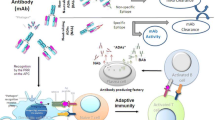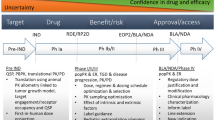Abstract
A mechanistic model of the immune response was evaluated for its ability to predict anti-drug antibody (ADA) and their impact on pharmacokinetics (PK) and pharmacodynamics (PD) for a biotherapeutic in a phase 1 clinical trial. Observed ADA incidence ranged from 33 to 67% after single doses and 27–50% after multiple doses. The model captured the single dose incidence well; however, there was overprediction after multiple dosing. The model was updated to include a T-regulatory (Treg) cell mediated tolerance, which reduced the overprediction (relative decrease in predicted incidence rate of 21.5–59.3% across multidose panels) without compromising the single dose predictions (relative decrease in predicted incidence rate of 0.6–13%). The Treg-adjusted model predicted no ADA impact on PK or PD, consistent with the observed data. A prospective phase 2 trial was simulated, including co-medication effects in the form of corticosteroid-induced immunosuppression. Predicted ADA incidences were 0–10%, depending on co-medication dosage. This work demonstrates the utility in applying an integrated, iterative modeling approach to predict ADA during different stages of clinical development.






Similar content being viewed by others
References
Deehan M, Garces S, Kramer D, Baker MP, Rat D, Roettger Y, et al. Managing unwanted immunogenicity of biologicals. Autoimmun Rev. 2015;14(7):569–74.
Baker MP, Reynolds HM, Lumicisi B, Bryson CJ. Immunogenicity of protein therapeutics: the key causes, consequences and challenges. Self Nonself. 2010;1(4):314–22.
Moticka EJ. Hallmarks of the adaptive immune response. In: Moticka EJ, editor. A historical perspective on evidence-based immunology. Waltham, MA: Elsevier; 2016. p. 9–19.
Chen X, Hickling TP, Vicini P. A mechanistic, multiscale mathematical model of immunogenicity for therapeutic proteins: part 2-model applications. CPT Pharmacometrics Syst Pharmacol. 2014;3:e134.
Chen X, Hickling TP, Vicini P. A mechanistic, multiscale mathematical model of immunogenicity for therapeutic proteins: part 1-theoretical model. CPT Pharmacometrics Syst Pharmacol. 2014;3:e133.
Cload et al. Fibronectin based scaffold domain proteins that bind to myostatin. United States Patent Application US20140107020A1, 2014.
Vita R, Overton JA, Greenbaum JA, Ponomarenko J, Clark JD, Cantrell JR, et al. The immune epitope database (IEDB) 3.0. Nucleic Acids Res. 2015;43(Database issue):D405–12.
Southwood S, Sidney J, Kondo A, del Guercio MF, Appella E, Hoffman S, et al. Several common HLA-DR types share largely overlapping peptide binding repertoires. J Immunol. 1998;160(7):3363–73.
U.S. National Library of Medicine NCfBI. BLASTP Suite for Protein Sequence Queries 2019 [Available from: https://blast.ncbi.nlm.nih.gov/Blast.cgi?PAGE=Proteins.
Tirucherai GS JL, Hamuro L, Ahlijanian M, Bechtold C and AbuTarif M. A target-mediated drug disposition model to characterize the PK-PD of BMS-986089 in healthy adults and its application to pediatric dose selection. ASCPT Abstracts. 2017.
Carneiro J, Leon K, Caramalho I, van den Dool C, Gardner R, Oliveira V, et al. When three is not a crowd: a crossregulation model of the dynamics and repertoire selection of regulatory CD4+ T cells. Immunol Rev. 2007;216:48–68.
Velez de Mendizabal N, Carneiro J, Sole RV, Goni J, Bragard J, Martinez-Forero I, et al. Modeling the effector - regulatory T cell cross-regulation reveals the intrinsic character of relapses in multiple sclerosis. BMC Syst Biol. 2011;5:114.
Maddur MS, Trinath J, Rabin M, Bolgert F, Guy M, Vallat JM, et al. Intravenous immunoglobulin-mediated expansion of regulatory T cells in autoimmune patients is associated with increased prostaglandin E2 levels in the circulation. Cell Mol Immunol. 2015;12(5):650–2.
Mukhopadhyay S, Varma S, Mohan Kumar HN, Yusaf J, Goyal M, Mehta V, et al. Circulating level of regulatory T cells in rheumatic heart disease: an observational study. Indian Heart J. 2016;68(3):342–8.
Wilson LD, Zaldivar FP, Schwindt CD, Wang-Rodriguez J, Cooper DM. Circulating T-regulatory cells, exercise and the elite adolescent swimmer. Pediatr Exerc Sci. 2009;21(3):305–17.
Mager DE, Moledina N, Jusko WJ. Relative immunosuppressive potency of therapeutic corticosteroids measured by whole blood lymphocyte proliferation. J Pharm Sci. 2003;92(7):1521–5.
Rohatagi S, Barth J, Mollmann H, Hochhaus G, Soldner A, Mollmann C, et al. Pharmacokinetics of methylprednisolone and prednisolone after single and multiple oral administration. J Clin Pharmacol. 1997;37(10):916–25.
Xu J, Winkler J. Derendorf H. a pharmacokinetic/pharmacodynamic approach to predict total prednisolone concentrations in human plasma. J Pharmacokinet Pharmacodyn. 2007;34(3):355–72.
Karosiene E, Rasmussen M, Blicher T, Lund O, Buus S, Nielsen M. NetMHCIIpan-3.0, a common pan-specific MHC class II prediction method including all three human MHC class II isotypes, HLA-DR, HLA-DP and HLA-DQ. Immunogenetics. 2013;65(10):711–24.
The dbMHC database provides an open, publicly accessible platform for DNA and clinical data related to the human Major Histocompatibility Complex (MHC). Produced and maintained in cooperation with the Medical University Graz, Austria. [Available from: https://www.ncbi.nlm.nih.gov/gv/mhc/main.fcgi?cmd=init.
2010–2102 CoID. Section 1: active and passive immunization: immunocompromised children. Red book: 2012 report of the Committee on Infectious Diseases. 29th ed. Elk Grove Village: American Academy of Pediatrics; 2012. p. 81–2.
Bryson CJ, Jones TD, Baker MP. Prediction of immunogenicity of therapeutic proteins: validity of computational tools. BioDrugs. 2010;24:1):1–8.
De Groot AS, Martin W. Reducing risk, improving outcomes: bioengineering less immunogenic protein therapeutics. Clin Immunol. 2009;131(2):189–201.
Caron E, Kowalewski DJ, Chiek Koh C, Sturm T, Schuster H, Aebersold R. Analysis of major histocompatibility complex (MHC) immunopeptidomes using mass spectrometry. Mol Cell Proteomics. 2015;14(12):3105–17.
Faulkner L, Gibson A, Sullivan A, Tailor A, Usui T, Alfirevic A, et al. Detection of primary T cell responses to drugs and chemicals in HLA-typed volunteers: implications for the prediction of drug immunogenicity. Toxicol Sci. 2016;154(2):416–29.
Karle A, Spindeldreher S, Kolbinger F. Secukinumab, a novel anti-IL-17A antibody, shows low immunogenicity potential in human in vitro assays comparable to other marketed biotherapeutics with low clinical immunogenicity. MAbs. 2016;8(3):536–50.
Schwartz RH. Historical overview of immunological tolerance. Cold Spring Harb Perspect Biol. 2012;4(4):a006908.
Szczepanik M. Mechanisms of immunological tolerance to the antigens of the central nervous system. Skin-induced tolerance as a new therapeutic concept. J Physiol Pharmacol. 2011;62(2):159–65.
Boer MC, Joosten SA, Ottenhoff TH. Regulatory T-cells at the interface between human host and pathogens in infectious diseases and vaccination. Front Immunol. 2015;6:217.
Joosten SA, Ottenhoff TH. Human CD4 and CD8 regulatory T cells in infectious diseases and vaccination. Hum Immunol. 2008;69(11):760–70.
Miller SD, Turley DM, Podojil JR. Antigen-specific tolerance strategies for the prevention and treatment of autoimmune disease. Nat Rev Immunol. 2007;7(9):665–77.
Sakaguchi S, Yamaguchi T, Nomura T, Ono M. Regulatory T cells and immune tolerance. Cell. 2008;133(5):775–87.
Takahashi T, Kuniyasu Y, Toda M, Sakaguchi N, Itoh M, Iwata M, et al. Immunologic self-tolerance maintained by CD25+CD4+ naturally anergic and suppressive T cells: induction of autoimmune disease by breaking their anergic/suppressive state. Int Immunol. 1998;10(12):1969–80.
von Herrath MG, Harrison LC. Antigen-induced regulatory T cells in autoimmunity. Nat Rev Immunol. 2003;3(3):223–32.
Anderson PO, Manzo BA, Sundstedt A, Minaee S, Symonds A, Khalid S, et al. Persistent antigenic stimulation alters the transcription program in T cells, resulting in antigen-specific tolerance. Eur J Immunol. 2006;36(6):1374–85.
Xue L, Fiscella M, Rajadhyaksha M, Goyal J, Holland C, Gorovits B, et al. Pre-existing biotherapeutic-reactive antibodies: survey results within the American Association of Pharmaceutical Scientists. AAPS J. 2013;15(3):852–5.
Xue L, Rup B. Evaluation of pre-existing antibody presence as a risk factor for posttreatment anti-drug antibody induction: analysis of human clinical study data for multiple biotherapeutics. AAPS J. 2013;15(3):893–6.
Gomez-Mantilla JD, Troconiz IF, Parra-Guillen Z, Garrido MJ. Review on modeling anti-antibody responses to monoclonal antibodies. J Pharmacokinet Pharmacodyn. 2014;41(5):523–36.
Perez Ruixo JJ, Ma P, Chow AT. The utility of modeling and simulation approaches to evaluate immunogenicity effect on the therapeutic protein pharmacokinetics. AAPS J. 2013;15(1):172–82.
Thway TM, Magana I, Bautista A, Jawa V, Gu W, Ma M. Impact of anti-drug antibodies in preclinical pharmacokinetic assessment. AAPS J. 2013;15(3):856–63.
Wang YM, Jawa V, Ma M. Immunogenicity and PK/PD evaluation in biotherapeutic drug development: scientific considerations for bioanalytical methods and data analysis. Bioanalysis. 2014;6(1):79–87.
Parra-Guillen ZP, Janda A, Alzuguren P, Berraondo P, Hernandez-Alcoceba R, Troconiz IF. Target-mediated disposition model describing the dynamics of IL12 and IFNgamma after administration of a mifepristone-inducible adenoviral vector for IL-12 expression in mice. AAPS J. 2013;15(1):183–94.
Gokemeijer J, Jawa V, Mitra-Kaushik S. How close are we to profiling immunogenicity risk using in silico algorithms and in vitro methods?: an industry perspective. AAPS J. 2017;19(6):1587–92.
Acknowledgments
The authors wish to thank the patients from the early clinical trial for contributing valuable data to support the analysis. We would like to thank Xiaoying Chen, Tim Hickling, and Paolo Vicini who developed and published the Pfizer model for immunogenicity prediction and made their model code publically available, which enabled our work. The work was partially presented previously in poster form at the 6th American Conference on Pharmacometrics (ACoP) held in Crystal City, VA, USA, in October 2015, and published in the meeting proceedings as abstract T-018 (Article in Journal of Pharmacokinetics and Pharmacodynamics 42:S51-S51, October 2015).
Author information
Authors and Affiliations
Contributions
All authors contributed to the design of the research. CT and LH wrote the manuscript. SC, AN, CT, and LH performed the research and analyzed data. CT conducted the modeling and simulation.
Corresponding author
Ethics declarations
Conflict of Interest
All authors were employees of Bristol-Myers Squibb at the time of this work.
Additional information
Publisher’s Note
Springer Nature remains neutral with regard to jurisdictional claims in published maps and institutional affiliations.
Rights and permissions
About this article
Cite this article
Hamuro, L., Tirucherai, G.S., Crawford, S.M. et al. Evaluating a Multiscale Mechanistic Model of the Immune System to Predict Human Immunogenicity for a Biotherapeutic in Phase 1. AAPS J 21, 94 (2019). https://doi.org/10.1208/s12248-019-0361-7
Received:
Accepted:
Published:
DOI: https://doi.org/10.1208/s12248-019-0361-7




